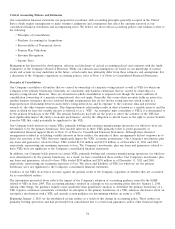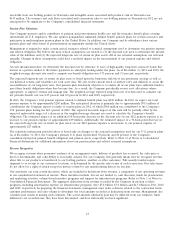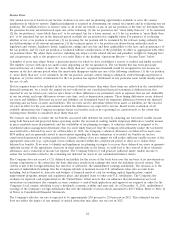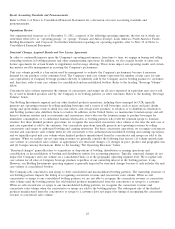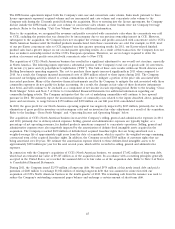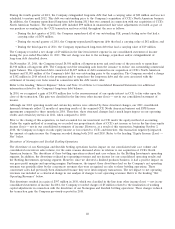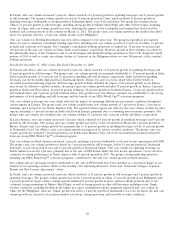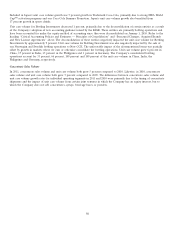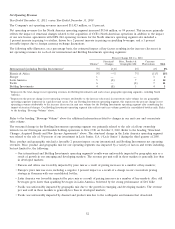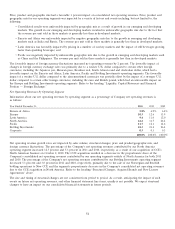Coca Cola 2011 Annual Report Download - page 46
Download and view the complete annual report
Please find page 46 of the 2011 Coca Cola annual report below. You can navigate through the pages in the report by either clicking on the pages listed below, or by using the keyword search tool below to find specific information within the annual report.‘‘Acquired brands’’ refers to brands acquired during the past 12 months. Typically, the Company has not reported unit case volume
or recognized concentrate sales volume related to acquired brands in periods prior to the closing of the transaction. Therefore,
the unit case volume and concentrate sales volume from the sale of these brands is incremental to prior year volume. We do not
generally consider acquired brands to be structural changes.
‘‘License agreements’’ refers to brands not owned by the Company, but for which we hold certain rights, generally including, but
not limited to, distribution rights, and we derive an economic benefit from the ultimate sale of these brands. Typically, the
Company has not reported unit case volume or recognized concentrate sales volume related to these brands in periods prior to
the beginning of the term of the license agreement. Therefore, the unit case volume and concentrate sales volume from the sale
of these brands is incremental to prior year volume. We do not generally consider new license agreements to be structural
changes.
Although there were no significant transactions that occurred during 2011, the following transactions and agreements impacted the
Company’s operating results during both 2011 and 2010:
• on October 2, 2010, in legally separate transactions, we acquired CCE’s North American business and entered into a
license agreement with DPS;
• on October 2, 2010, we sold all of our ownership interests in our Norwegian and Swedish bottling operations to New CCE;
and
• on January 1, 2010, we deconsolidated certain entities, primarily bottling operations, as a result of the Company’s adoption
of new accounting guidance issued by the FASB.
The impact that each of the aforementioned items had on the Company’s consolidated financial statements is discussed
throughout this report, as appropriate. The sections below are intended to provide an overview of the impact these items had on
our 2011 and 2010 operating results and are expected to have on key metrics used by management.
Acquisition of CCE’s North American Business and the DPS License Agreements
Immediately prior to our October 2, 2010, acquisition of CCE’s North American business, the Company owned 33 percent of
CCE’s outstanding common stock. This ownership represented our indirect ownership interest in both CCE’s North American
business and its European operations. On October 2, 2010, the Company acquired the remaining 67 percent of CCE’s North
American business not already owned by the Company for consideration that included the Company’s indirect ownership interest
in CCE’s European operations. As a result of this transaction, the Company now owns 100 percent of CCE’s North American
business and does not own any interest in New CCE’s European operations. The operating results of CCE’s North American
business were included in our consolidated financial statements starting October 2, 2010. The operating results of New CCE do
not directly impact the Company’s consolidated financial statements, since we have no ownership interest in this entity. Refer to
the heading ‘‘Our Business — General’’ above and Note 2 of Notes to Consolidated Financial Statements for additional details
related to the acquisition.
On October 2, 2010, the Company also entered into an agreement with DPS to distribute certain DPS brands in territories where
these brands were distributed by CCE prior to our acquisition of CCE’s North American business. The license agreements
replaced agreements between DPS and CCE existing immediately prior to our acquisition of CCE’s North American business.
Refer to the heading ‘‘Our Business — General’’ above and Note 2 of Notes to Consolidated Financial Statements for additional
details related to these new license agreements.
Prior to the acquisition of CCE’s North American business and entering into the DPS license agreements, the Company’s North
America operating segment was predominantly a concentrate operation. As a result of the acquisition of CCE’s North American
business and the DPS license agreements, the North America operating segment is now predominantly a finished products
operation. Generally, finished products operations produce higher net operating revenues but lower gross profit margins and
operating margins compared to concentrate operations. Refer to ‘‘Item 1. Business — Products and Brands’’ for additional
discussion of the differences between the Company’s concentrate operations and our finished products operations. These
transactions resulted in higher net operating revenues but lower gross profit margins and operating margins for the North
America operating segment and our consolidated operating results.
Prior to the acquisition of CCE’s North American business, the Company reported unit case volume for the sale of Company
beverage products sold by CCE. After the transaction closing, we reported unit case volume of Company beverage products just as
we had prior to the transaction.
Prior to the acquisition of CCE’s North American business, the Company recognized concentrate sales volume at the time we sold
the concentrate to CCE. Upon the closing of the transaction, we do not recognize the concentrate sales volume until CCR has
sold finished products manufactured from concentrate to a customer.
44


